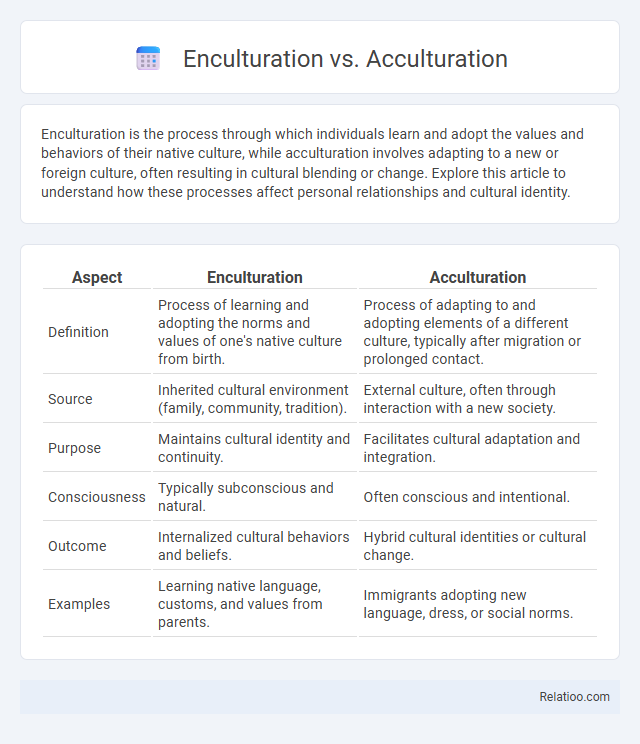Enculturation is the process through which individuals learn and adopt the values and behaviors of their native culture, while acculturation involves adapting to a new or foreign culture, often resulting in cultural blending or change. Explore this article to understand how these processes affect personal relationships and cultural identity.
Table of Comparison
| Aspect | Enculturation | Acculturation |
|---|---|---|
| Definition | Process of learning and adopting the norms and values of one's native culture from birth. | Process of adapting to and adopting elements of a different culture, typically after migration or prolonged contact. |
| Source | Inherited cultural environment (family, community, tradition). | External culture, often through interaction with a new society. |
| Purpose | Maintains cultural identity and continuity. | Facilitates cultural adaptation and integration. |
| Consciousness | Typically subconscious and natural. | Often conscious and intentional. |
| Outcome | Internalized cultural behaviors and beliefs. | Hybrid cultural identities or cultural change. |
| Examples | Learning native language, customs, and values from parents. | Immigrants adopting new language, dress, or social norms. |
Understanding Enculturation: Definition and Key Concepts
Enculturation refers to the process by which individuals learn and adopt the values, beliefs, customs, and norms of their native culture through direct interaction and socialization within their community. This lifelong process shapes your identity and worldview by internalizing cultural knowledge from family, peers, and institutions. Understanding enculturation is essential for distinguishing it from acculturation, which involves adapting to a different culture, often in a new environment.
Acculturation Explained: Meaning and Core Elements
Acculturation refers to the process by which individuals or groups adopt the cultural traits or social patterns of another group, often occurring when different cultures come into direct continuous contact. Core elements of acculturation include assimilation, integration, separation, and marginalization, each describing different outcomes based on the degree of cultural exchange and adaptation. Unlike enculturation, which is the internalization of one's native culture from birth, acculturation involves adaptation to an external culture, influencing language, customs, values, and social behaviors.
The Process of Enculturation in Everyday Life
Enculturation is the lifelong process through which You internalize the values, norms, language, and customs of Your own culture, shaping Your identity and social behavior from childhood to adulthood. This process occurs naturally in everyday life through family interactions, education, media exposure, and community participation, embedding cultural knowledge deeply and unconsciously. Enculturation differs from acculturation and socialization by emphasizing the internal assimilation of one's native culture rather than adapting to a new culture or broader social norms.
Acculturation in Multicultural Societies
Acculturation in multicultural societies involves the process through which individuals or groups adopt cultural traits or social patterns of another group while maintaining aspects of their original culture. This dynamic exchange shapes identity, communication, and social cohesion, impacting your ability to navigate diverse environments effectively. Understanding the distinctions between enculturation, the internalization of one's native culture, and acculturation, the adaptation to a new culture, is vital for fostering inclusivity and mutual respect in multicultural contexts.
Key Differences Between Enculturation and Acculturation
Enculturation is the process by which You learn and internalize the norms, values, and customs of Your native culture from birth, shaping Your identity within that specific community. Acculturation occurs when an individual or group adopts elements of a different culture, often through prolonged contact, resulting in changes to cultural practices and social behaviors. The key difference lies in enculturation being an inward, lifelong acquisition of one's original culture, whereas acculturation involves adapting to and integrating aspects of an external culture.
Enculturation: Role in Identity Formation
Enculturation plays a crucial role in identity formation by immersing individuals in the values, norms, and customs of their native culture, shaping their worldview and self-concept from childhood. Your sense of belonging and cultural identity is fundamentally constructed through continuous interactions with family, community, and social institutions during enculturation. Unlike acculturation, which involves adapting to a new culture, enculturation preserves core cultural elements essential for maintaining personal and collective identity.
Acculturation: Adaptation and Cultural Exchange
Acculturation involves the process through which individuals or groups adapt to and adopt elements from another culture, often resulting in a dynamic cultural exchange that reshapes identities and social norms. Unlike enculturation, which is the transmission of culture within one's original community, acculturation emphasizes the interaction and blending between different cultures. Your understanding of acculturation highlights how adaptation fosters mutual influence, reshaping behaviors, values, and traditions through continuous intercultural contact.
Factors Influencing Enculturation and Acculturation
Enculturation is influenced by family practices, cultural rituals, language use, and social norms that shape an individual's identity within their native culture. Acculturation involves factors such as exposure to a dominant culture, duration of contact, motivation to adapt, and social support networks that facilitate or hinder the integration process. The intensity of cultural interaction, personal attitudes towards both cultures, and institutional policies also significantly impact how individuals navigate between enculturation and acculturation.
Challenges and Benefits of Acculturation
Acculturation presents challenges such as identity confusion, language barriers, and social integration difficulties, impacting mental health and community belonging. Benefits of acculturation include increased cultural awareness, enhanced social skills, and greater adaptability in diverse environments. Unlike enculturation, which involves internalizing one's native culture from birth, acculturation requires navigating and blending multiple cultural norms, often fostering cross-cultural understanding and personal growth.
Enculturation vs Acculturation: Real-World Examples
Enculturation involves the process by which individuals learn and assimilate the norms, values, and behaviors of their own culture from birth, while acculturation refers to the adaptation and modification of cultural traits when interacting with a different culture. For example, a child growing up in a traditional Japanese household is undergoing enculturation by absorbing local customs, whereas an immigrant adapting to American social practices reflects acculturation. Understanding these differences helps you navigate cultural integration and identity in diverse social environments.

Infographic: Enculturation vs Acculturation
 relatioo.com
relatioo.com